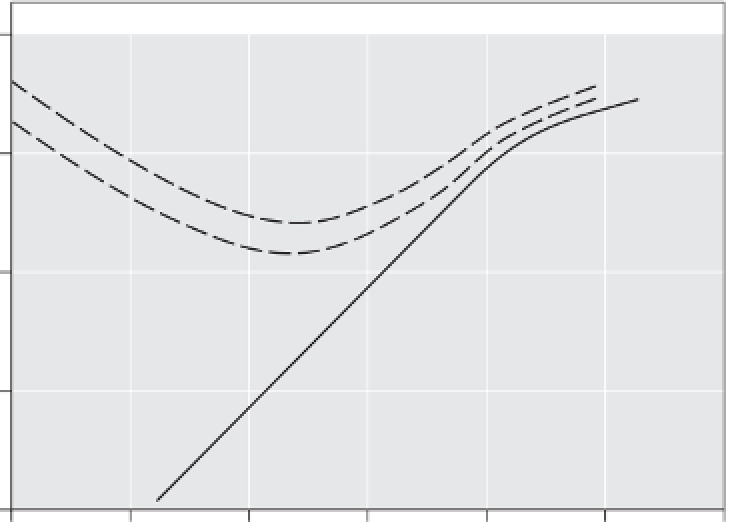Geology Reference
In-Depth Information
Clay
Silt
Sand
Coarse material
10
Erosion
1
e
0.1
Transport
Deposition
0.01
Fall
velocity
0.001
0.001
0.01
0.1
1
Particle size (mm)
10
100
1,000
Figure 3.11
The Hjulstrøm diagram showing the water velocity at which entrainment and deposition occur for
particles of a given size in well-sorted sediments.
Source:
Adapted from Hjulstrøm (1935)
hollow is ground out that may eventually deepen to
produce a
pothole
.
surface (Figure 3.12). Horton proposed that a '
belt of no
erosion
' is present on the upper part of slopes because
here the flow depth is not sufficient to cause erosion.
However, subsequent work has demonstrated that some
surface wash is possible even on slope crests, although
here it does not lead to rill development because the
rate of incision is slow and incipient rills are filled by
rainsplash.
Further studies have demonstrated that a range of
relationships between channel network properties and
topography exist, although the physical processes driv-
ing these are not as well understood. In semi-arid and
arid environments, the Hortonian overland-flow model
provides a reasonable framework for explaining channel
initiation, but it does not for humid regions. In humid
regions, channel initiation is more related to the location
of surface and subsurface flow convergence, usually in
slope concavities and adjacent to existing drainage lines,
than to a critical distance of overland flow. Rills can
develop as a result of a sudden outburst of subsurface
flow at the surface close to the base of a slope. So channel
Channel initiation
Stream channels can be created on a newly exposed sur-
face or develop by the expansion of an existing channel
network. Their formation depends upon water flow-
ing over a slope becoming sufficiently concentrated for
channel incision to occur. Once formed, a channel may
grow to form a permanent feature.
Robert E. Horton (1945) was the first to formalize
the importance of topography to hillslope hydrology by
proposing that a
critical hillslope length
was required
to generate a channel (cf. p. 66). The critical length was
identified as that required to generate a boundary shear
stress of Hortonian overland flow sufficient to overcome
the surface resistance and result in scour. In Horton's
model, before overland flow is able to erode the soil,
it has to reach a critical depth at which the eroding
stress of the flow exceeds the shear resistance of the soil


